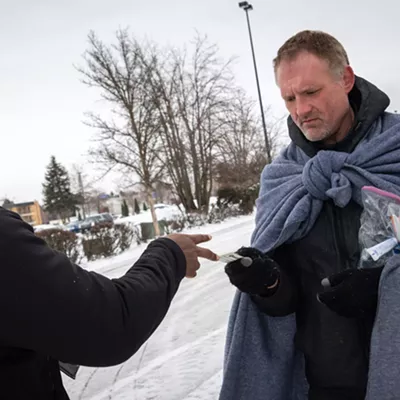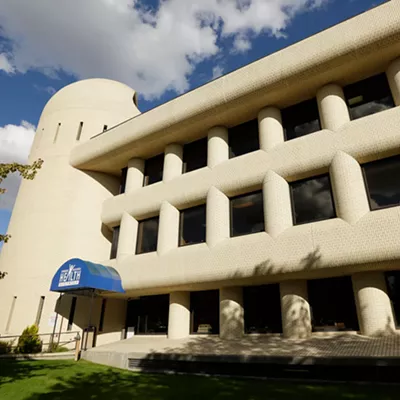
For years, residents in Latah Valley have been sounding the alarm about public safety hazards in their southwest Spokane neighborhoods, which straddle U.S. Route 195.
They've pointed to warnings from the Washington State Department of Transportation, which is concerned with increasing strains on the highway from new housing developments. With more people merging onto the busy road to get to the interstate and downtown, WSDOT has threatened to close highway crossings at some of the busiest intersections unless the city starts building other transportation routes, including public transit and pedestrian options.
But other safety concerns came to the forefront this summer, after wildfires threatened homes and neighborhoods on the edge of town, where the city abuts wildland. In May, two homes burned down in different parts of the valley. A 155-acre wildland fire prompted evacuation notices in July, and two significant fires in August prompted evacuations again.
To address the concerns, Citizen Action for Latah Valley, or CALV, is calling for a moratorium on development until a better plan for that area is formulated and the city funds a permanent fire station in the area. (Spokane City Council approved a six-month moratorium on development in Latah Valley in September 2022 to work on updating fees related to infrastructure costs for new developments. That lapsed in March.)
"Our biggest ask right now is a moratorium, because we have a serious safety issue, multiple safety issues," says Molly Marshall, who started CALV two years ago with her husband, Adam, and fellow Latah Valley resident, Kai Huschke. "After this fire season, I think the next biggest ask is a fire station."
Already, the group has gotten support for the moratorium from some running to lead Spokane, including City Council candidate Paul Dillon, who would represent that area; Betsy Wilkerson, a current council member who is running for council president; and Lisa Brown, who is challenging Mayor Nadine Woodward.
Dillon's opponent, Katey Treloar, is opposed to another moratorium but says she supports the residents and wants to see a plan come together for that area. Meanwhile, the development community is already speaking out against the potential for another building pause.
TRAPPED
The Marshalls started CALV two years ago, following problems with a developer building near their home in the Grandview/Thorpe neighborhood. But this year, they experienced firsthand how cracks can appear in the public safety response.
On Aug. 3, an arsonist started a fire near South Rustle Street and the Sunset Highway, prompting evacuations north of the interstate.
A first responder began going through Grandview/Thorpe, on the other side of the freeway, knocking on doors and telling people to evacuate to the south, Molly Marshall says. But the neighborhood is a maze of streets, and residents on 17th Avenue can't go south to leave the neighborhood. They can take Garden Springs/Rustle (where the fire was actively burning), or a meandering route back to 16th to get on the highway, or Lindeke to get to a different part of Sunset. None of them are a direct route to safety.
"Our whole neighborhood's trapped," Molly Marshall says. "That's a big issue."
Their elderly neighbors later said they never got an alert about the fire.
Spokane Fire Chief Brian Schaeffer says the risk fire poses to that area of town is well established, and something he's been warning against.
"I'm very concerned for southwest Spokane and the level of fire protection we can deliver based on the increasing danger from the wildland-urban interface, climate change, heat domes," Schaeffer says. "This last fire season — we predicted this, and we've been talking about this for years. Now that it finally occurred in Spokane County, I think a lot of people have realized the reality we have been warning against is here."
Southwest Spokane is served by Spokane Fire Department Station 5, which in 2015 was "temporarily" put in a former model home in the Eagle Ridge neighborhood. The plan was to build a permanent fire station near Cheney-Spokane Road and U.S. Route 195 within a few years. That station has yet to be funded.
During the summer, the department is able to keep a "Type 1" engine in a fenced area outside Station 5 that is staffed with a paramedic and two other firefighters like other trucks that would respond throughout the city, Schaeffer says. But that truck can't stay during the winter due to water storage on the vehicle.
The department is working with an outside firm to estimate what it would cost to design and replace Station 5 and other stations in the city. Schaeffer hopes to present the results to the council in October.
The fire department has included the new station in its budget requests for several years, but multiple mayors and iterations of the City Council have yet to pay for it. Meanwhile, the temporary station is what they have to work with.
"It's not a permanent solution to what has become probably the largest growth area in Spokane," Schaeffer says. "We need to have a more robust discussion on what a fire-adapted community means, and what measures are the responsibility of government, and what measures are the responsibility of developers, and what measures are the responsibility of property owners and occupants."
CALV is calling on residents to ask the City Council to pass another building moratorium to allow the city to do just that.
A request for comment through the mayor's spokesperson, Brian Coddington, wasn't answered.
MORE PROBLEMS?
On Aug. 16, CALV held a meeting with state, city and county officials, and also invited candidates running for office this year. Among other issues, they talked about fire safety and called for a moratorium.The next day, Brown, Wilkerson and Dillon issued a joint press release calling for another pause on development in the area until public safety facilities could be planned for and funded. The day after that, the devastating Gray and Oregon fires destroyed hundreds of homes in Medical Lake and Elk, and burned more than 20,000 acres.
Dillon, who used to live in Grandview/Thorpe, says he knows well how difficult it can be crossing U.S. 195 to head toward other parts of the city. He's also concerned with the limited routes out of the neighborhood.
"I don't think that many people outside of Latah really understand what is happening here and what it's like," Dillon says. "You have this continuation of development happening without comprehensive planning, and already it's stretched our resources so thin, from fire to police."
Dillon supports another moratorium to allow six months to a year for the city to specifically identify upgrades and plan how to pay for them.
"Residents have been very clear that this is what they want," Dillon says.
His opponent, Treloar, drove through the area last week, issuing a video and press release acknowledging the dead-end road issues and traffic safety concerns. But Treloar doesn't support a moratorium.
Instead, she thinks the city should plan to pay for needed improvements without pausing development.
"One of the things I want to make very clear is I support the neighborhood and their needs. I understand they feel right now the moratorium is the only way for their voice to be heard," Treloar says. "I'm sad they feel they had to get to this point, but I think we can help support these neighborhoods while at the same time getting the infrastructure in place."
Treloar says the neighborhood needs a voice on the council prioritizing their needs. Council could write a policy ensuring that the fees collected from developers in that area are invested back into Latah Valley, because that's not guaranteed right now.
"If we're going to collect those fees and use them for infrastructure, then we can't limit building at the same time," Treloar says. "There's a way to help the Latah Valley without a moratorium. A moratorium is more of a social statement I think candidates are using just to get votes."
That's in line with the Spokane Association of Realtors, which opposed the moratorium a year ago. Association President Tom Hormel says the city would do better by those neighborhoods to ensure developer fees are invested in that area.
Ironically, he says a lot of the things that are lacking — parks, schools, public transportation — aren't going to be possible until the population grows.
"What I've been told is they don't have enough population right now to warrant a school or fire station, so the solution to that is actually to put in the homes," Hormel says. "Just shutting down building isn't the answer there."
Hormel also says that a pause will put increased pressure on the housing market, which is already overpriced for many. He blames the city for not acting sooner.
"The city's got to come to the table with money to help do this stuff, instead of telling developers or builders, 'We need $10 million to do this new road, you have to pay for that,'" Hormel says. "That's not fair either. These are city roads. We need a plan."
Dillon says a moratorium would allow the city time to actually figure out how to pay for investments there, and says it's not NIMBYism.
"This is not affordable housing to most people in Spokane, or low-income housing when we see these development proposals," Dillon says. "And now, you have to live in fear of the constant threat of evacuation." ♦
























